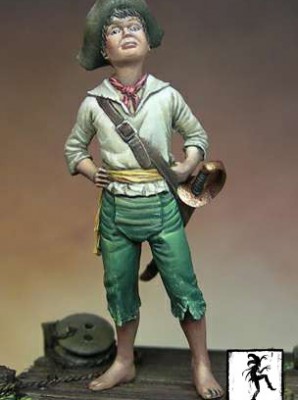John King (45 mm)
54 mm
45 mm
Benoit Cauchies
Jérémie Bonamant Teboul
Jean Ramet
« Finest quality polyurethane resin, supplied unpainted. Not suitable for children under 36 months due to small pieces. The photography presents an exemple of the painted miniature.
Historique
"Some pirates were renowned for their cruelty, others for their exploits, real or imagined. John King is not known for these reasons. Like the pirate women, it was the strength of his character that allowed this 9 to 11 year old boy to join the crew of the pirate Sam Bellamy.
While teenage pirates were common in the 18th century and the Royal Navy employed young boys as "powder monkeys" to carry gunpowder from ship's magazine to their cannons, boys of King's age were unknown as pirates.
On November 9, 1716, Bellamy and his crew, sailing the sloop Mary Anne attacked and captured the Antiguan sloop Bonetta, which was then en route from Antigua to Jamaica . John King, then aged between eight and eleven, was a passenger on the Bonetta. King demanded to join Bellamy's crew. He declared he would kill himself if he was restrained, and even threatened his Mother, who was then on board as a passenger.
Bellamy allowed King to join him. In the subsequent months, Bellamy and his crew would capture and loot many ships, including the Whydah, a heavily-armed slave galley which Bellamy claimed for his flagship. On April 26, 1717, the Whydah was wrecked in a storm off the coast of Cape Cod , killing Bellamy and most of his crew, including King.
King's remains were tentatively identified in 2006 when had partial human remains recovered from the wreck analyzed by researchers at the Smithsonian Institution and Center for Historical Archaeology in Florida . The remains, consisting of an 11-inch fibula encased in a shoe and linen stocking, were determined not to belong to a small man, as originally thought, but to a young boy of King's approximate age.
This revealed a new part of the history of piracy ..."


















